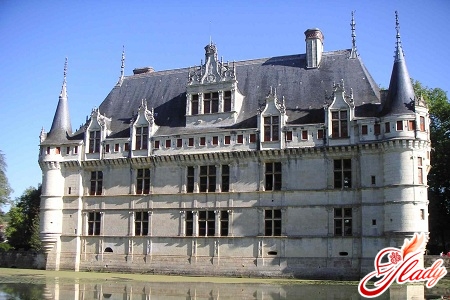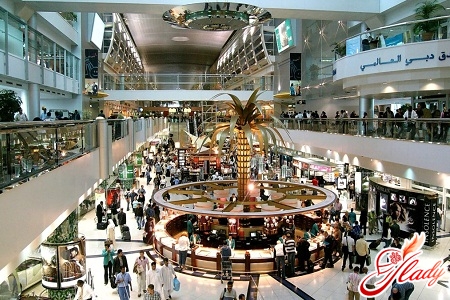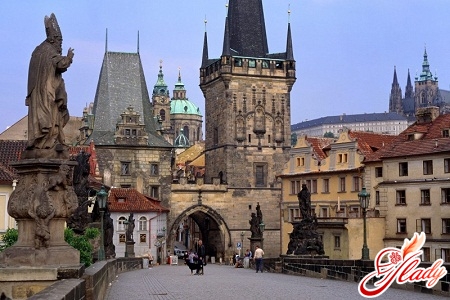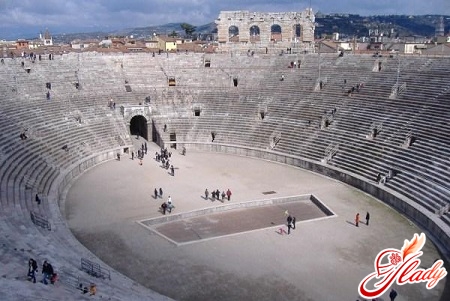
Verona is small but very cozya city that is rightfully considered one of the most beautiful in the world. The city has preserved cultural and historical monuments, ancient landmarks and simply beautiful places that can turn a walk into a fabulous and truly exciting journey.
Verona Amphitheater
The famous Verona Amphitheater is located onPiazza Bra is the main square of the city. In terms of size, it is the third ancient amphitheater, which was built in the era of Ancient Rome. Historians date this structure to 30 AD: at that time, the building consisted of 4 elliptical rings, and was faced with pink and white limestone. Today, its façade is made of brick, river pebbles and stone. In 2000, the Verona Amphitheater was included in the World Heritage List, which is protected by UNESCO. About 2 thousand years ago, on the stage of the amphitheater, which accommodated more than 30 thousand people, gladiator fights, distinguished by cruelty, circus performances and naval battles-naumachias were held. Even at that time, today's landmarks of Italy began to be created. Unfortunately, a strong earthquake that occurred in 1117 almost completely destroyed the outer walls of the building. But even after that, the role of the arena did not diminish: in the Middle Ages, the arena hosted knightly tournaments, festivals, demonstration executions of heretics, and bullfights, which Italy can boast of to this day. In the 20th century, the amphitheater became one of the main venues in Verona, where opera performances are held, annually gathering more than half a million spectators. The first performance was Giuseppe Verdi's Aida, which became a kind of calling card of this theater stage. Since then, many legendary performers have performed there, such as Luciano Pavarotti, Maria Callas, Renata Tebaldi, Placido Domingo and other world-famous stars. The arena also hosts concerts of pop music stars. Until recently, the amphitheater's capacity was 20,000 spectators, but now, for safety reasons, it has been reduced to 5,000. Thanks to the amphitheater, thousands of tourists visit other, lesser-known attractions in the city.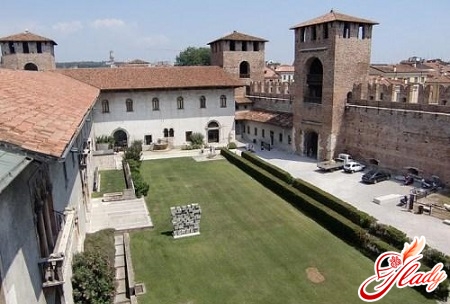
Roman Ancient Theater
The Roman ancient theatre is located on the territoryVerona on the San Pietro hill. This building was built at the end of the 1st century AD. Today, the cavea with steps, brick-built scenes, and orchestras with seats for important spectators are well preserved. Directly in front of the stage is the proscenium, behind which the curtain was once located. The width of the cavea is 105 meters, while it "rests" on the hill, and is supported by walls on the sides. In ancient times, there were 3 wide terraces above it. Today, the famous Castel San Pietro rises in their place. The ancient Roman theater was decorated with semi-columns of a different style on each floor: on the first floor it was Tuscan style, on the second - Ionic, and on the last one there were pillars. It is noteworthy that the attractions: the ancient Roman theater and the Verona Amphitheater - are often confused. The theater is located very close to the Adige River, which is why it repeatedly suffered from severe floods, which led to the fact that already in the Middle Ages its entire site was filled in and built up with buildings. Once upon a time, the residence of Theodoric the Great, the king of the Ostrogoths, was located on the territory of the ancient Roman theater. Only in 1830 did they begin to bring the theater back to life: the dilapidated buildings that were erected on the site of the stage were completely demolished, the amphitheater itself was carefully dug up, and numerous arches and a wide staircase were restored. In 1851, the remains of an ancient temple crowning the building of this theater were discovered on the San Pietro hill. Its "discoverer" was the wealthy businessman Andrea Monga, who bought this territory and ordered excavations to be carried out on it. In 1904, all the land on which the building is located became the property of Verona. It is worth noting that the whole of Northern Italy does not have a more majestic theater. Today, next to the ancient theater stands the monastery of San Girolamo and the Church of Sir and Libera, which was built in the 10th century. Saint Sir is the first Christian priest of the city, who secretly performed liturgies in the theater building.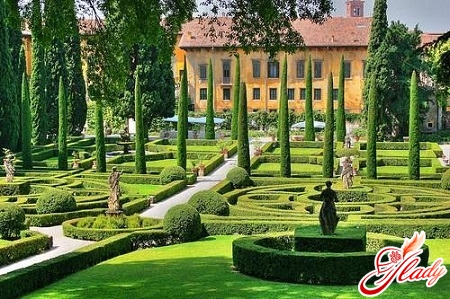
The famous arch of Gavi
The Arch of Gavi was built according to the design of LuciusVitruvius Cerdon in the second half of the 1st century. The arch received its name in honor of the Gavia family, which was considered one of the most noble at that time. In the Middle Ages, this arch was located in the city wall and was used as the main entrance to the city. Verona was surrounded by this wall by decision of the City Council. In the 16th century, various buildings were added to the arch - shops and artisans' stalls. During the Renaissance, architects and artists took the Arch of Gavi as a model of the true classical style in the construction of churches, chapels and chapels, which are abundant throughout Northern Italy. In 1805, when all of Italy was captured by Napoleon, the arch was completely dismantled to facilitate access to the city for French troops. The stones of the monument were first placed in Piazza Cittadella, and a little later moved to the Verona amphitheater. In 1814, to make way for a new road, the lower parts of the columns and the base of the arch, which remained in place, were dismantled. The historical monument was restored in 1932 from the surviving materials and erected near its original location, near Castelvecchio Castle. The Gavi Arch has only one span. The facades of the arch are decorated with half-columns, and the opening itself is decorated with a decorative frieze with a beautiful plant ornament. The height of the structure is 12 m 69 cm. The facade faces Via Postumia. The pedestal of the arch is made of 4 limestone blocks, the columns are made of 11 blocks, and the attic and entablature used only 3 blocks each. Statues depicting members of the Gavi family once stood in the side niches of the structure. An interesting detail: right under the arch itself you can see a fragment of a bridge road that was built in Ancient Rome. Italy would lose many tourists without such a majestic arch.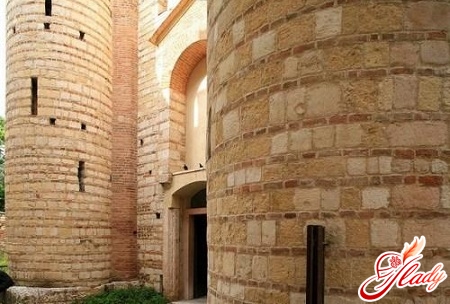
Three arches of Scaligers
These arches were located near the church.Santa Maria. The Scaliger Arches are Gothic tombstones of three medieval rulers from the Scaliger family, who ruled in the 13th and 14th centuries. The arches were made based on the hanging sarcophagus of Guglielmo di Castelbarco, which was built in 1320. Today, this sarcophagus can be seen near the Anastasia Church. At the entrance to the Santa Maria Church, there is a copy of the Arch of Cangrande I, which is made in the form of a tabernacle - an open tower-like extension. The original Arch of Cangrande I is kept in the large museum of Castelvecchio. The author of this creation is unknown, but many art historians believe that the arch was erected by Giovanni Rigino. Cangrande I is considered the greatest of the Scaliger family; he is depicted on the tombstone in two poses: sitting on a horse and lying in the arms of death. This tombstone is one of the most outstanding examples of Italian sculpture of the 14th century. These landmarks are among the most famous in Verona. The second arch is Mastino II. This structure is decorated with numerous figures of saints and angels, and Mastino himself is depicted on the arch sitting on a horse and dressed in armor. The construction of this arch was begun during the life of this ruler, but he died in 1351. The last arch, the Arch of Cansignorio, was built in 1375 by masters from Bologna Bonino da Campione and Gaspare Broaspini, has a hexagonal shape, and is decorated with twisted columns. On the edges of the tombstone there are bas-reliefs and sculptures, and at the top there is a statue of Cansignorio. By the end of the 16th century, the Scaliger Arches fell into complete disrepair. The restoration of the monument was carried out only in 1839. Today these attractions attract thousands of tourists every year. Not far from the Scaliger arches are the burial places of other members of this family.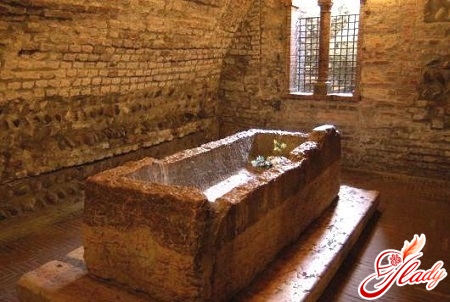
The world famous house of Juliet
Juliet's house is perhaps the mosta popular landmark in Verona, visited by thousands of lovers from all over the world. This house was built in the 13th century and is known to the whole world thanks to William Shakespeare. Once upon a time, this house, which is located near Piazza Erbe, was the property of the Dal Cappello family, which became the prototype of the Capulet family. The family coat of arms in the form of a marble hat can still be seen today on the arch that leads to the courtyard. In the 17th century, the house was sold and since then it has changed owners several times until it was bought by the Verona City Council in 1907 to organize a museum there. By this time, the house had become practically dilapidated and required restoration and repair work. The municipality could not find the funds for this for a very long time, and only in 1936, after the release of the famous film "Romeo and Juliet" by George Cukor, active work began, which was aimed at turning the house into an open tourist site, with which all the existing attractions could not be compared. Juliet's house, in accordance with Shakespeare's play, was given a romantic look: the façade was decorated with elements of the Gothic style, the windows were beautifully framed, and some buildings facing the inner courtyard were reconstructed. The courtyard itself with Juliet's balcony was also rebuilt and became very similar to the courtyard from Cukor's film: a column under the balcony and a crenellated wall appeared. Later, lines from Shakespeare's play were placed on the wall. In 1972, a bronze statue of Juliet was installed there, which is still very popular with tourists. It is believed that if a person touches the right breast of the statue, he will have luck in love. Restoration work on the house was carried out in the 1970s and 1990s. During the last restoration, the atmosphere and romance of the 14th century were recreated in the house using appropriate frescoes and ornaments. In 1997, a museum was opened in Juliet's house. Today, you can see various works of art that were created on the theme of "Romeo and Juliet", photographs and a collection of objects from the film by Franco Zeffirelli: the marriage bed, two costumes and sketches. Tourists visiting Juliet's house leave declarations of love on the walls. These Shakespearean landmarks can even compete with the Statue of Liberty.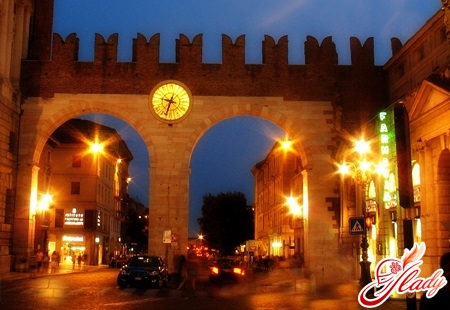
Ponte Pietra Bridge
Translated from Italian, Ponte Pietra means"stone bridge". Ponte Pietra is an arched bridge that connects the banks of the Adige River. It was built almost at the end of the 1st century BC and was originally called Pon Marmoreus. As a result of a large number of reconstructions due to earthquakes and floods, it received its current name. The Postumian Way once crossed the bridge, leading from Genoa to a large pass located in the Alps. In ancient Roman times, a similar bridge was built nearby - Ponte Postumio. The total length of Ponte Pietra is 95 meters. At the end of World War II, Ponte Pietra was blown up by retreating German troops. In 1959, it was restored, and many original fragments were raised from the bottom of the river. Of course, not all the components of the destroyed structure were found, so a variety of materials were used for its reconstruction. In addition to white marble, red brick was used, which made the bridge more picturesque. Thanks to this, the city's attractions received another majestic structure that survived hundreds of years on their list. At one time, Ponte Pietra was the only stone bridge in Verona.
Valpolicella Valley
Valpolicella is a picturesque valley,spread out in the vicinity of Verona. This valley has gained worldwide fame thanks to the wines "Recioto", "Amarone" and "Ripasso". There are many historical and cultural values in the valley that are worth visiting. Even having seen the sights of the whole world, this valley will be remembered forever. Tourists will like the cozy towns in the medieval style: Pedemonte, San Pietro Incariano, Negrar, Fumane. In each of these towns you can find more than one good winery. In addition to wine, Valpolicella is famous for the delicacies of local cuisine. For example, aged or fresh cheese "Monte Veronese", which is produced in the mountains of Verona, sausage "Risotto al Amarone" or "Soppressa". Lovers of natural beauty will not be disappointed either. The territory of Northern Italy has the most beautiful landscapes and scenery. Thus, in the city of Molina, which is located near Fumane, there is a very beautiful park "Cascades of Molina" with hiking trails and picturesque waterfalls. It is very easy to get to the Valpolicella Valley, since it is also Verona and all the residents know how to get there.
Verona Cathedral
Verona Cathedral is the mainthe city's church, and it is here that the bishop's see is located. The construction of the Romanesque temple began in the second half of the 12th century. The construction was carried out on the site of two pre-Christian churches that were destroyed by an earthquake in 1117. The new cathedral was completed and consecrated in 1187. In the 15th century, several rooms were added to the temple, which gave it a late Gothic outline. Only the entrance portal, decorated with winged griffins, has survived from the original appearance of the building. Above the entrance to the cathedral, you can see an image of the Virgin Mary holding the little Jesus in her arms. The portal is also decorated with various scenes from the Old Testament and figures of Roland and Olivier - knights from the medieval epic. These artistic landmarks are famous throughout the world. There are also images of ten prophets, the Hand of the Lord, and four evangelical symbols. The Gothic windows of the cathedral's facades are a reminder of the major restoration that took place in the 14th century. The Baroque elements located at the top of the building were added in the 17th century. The bell tower, which Michele Sanmicheli began to build in the mid-16th century, remained unfinished. Historians note that these are not all the city's landmarks that this architect touched. Inside, the cathedral is built in the Gothic style: pointed arches, red marble columns, vaults with golden stars on a soft blue background. The side altars and chapels were decorated by Giovanni Falconetto in the 16th century. There you can also see true works of art: "Assumption of the Virgin Mary" by Titian, "The Entombment" by Giolfino and "Adoration of the Magi" by Liberale da Verona. Thanks to these creators, Italy received an undying history. Next to the cathedral is the cloister, which is also built in the Romanesque style. The cloister is framed by a covered two-level gallery made of marble. From there you can go to the church's manuscript repository and the baptistery, built back in 1123. The baptistery contains many frescoes and paintings from the 13th to 15th centuries, and in the central nave there is a font carved in the 12th century from a single piece of marble.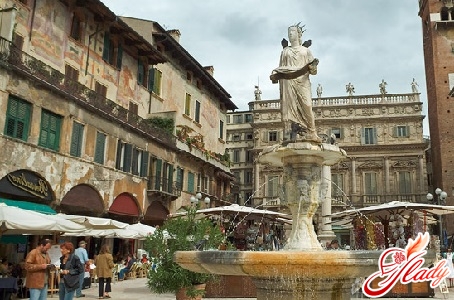
St. Peter's Castle
This castle was built on the San Pietro hill inVerona. Italy is proud of this building. The Castle of St. Peter stands on the site of an ancient Roman temple. The place for the construction of the castle was not chosen by chance: the picturesque hill, from which the entire city and the Adige River are visible, is an excellent strategic point. In ancient Roman times, the first fortification was built at the foot of the hill, with the help of which the crossing of the Adige was controlled, and a little later, a city appeared on the opposite bank, which later became Verona. All the sights of the city owe their appearance to this building, which gave life to Verona. During the time when Italy was under the rule of the Venetian Republic, San Pietro with all the internal buildings was the residence of the military commandant. Major restoration work in the castle was carried out at the beginning of the 17th century. Numerous rooms for soldiers were repaired, the barracks for infantrymen were expanded, which after restoration could accommodate up to 460 people. In the 19th century, Napoleon seized power over the city, whose troops destroyed the entire castle. During those years almost all the sights of Italy were destroyed. Of course, the castle was later restored.






